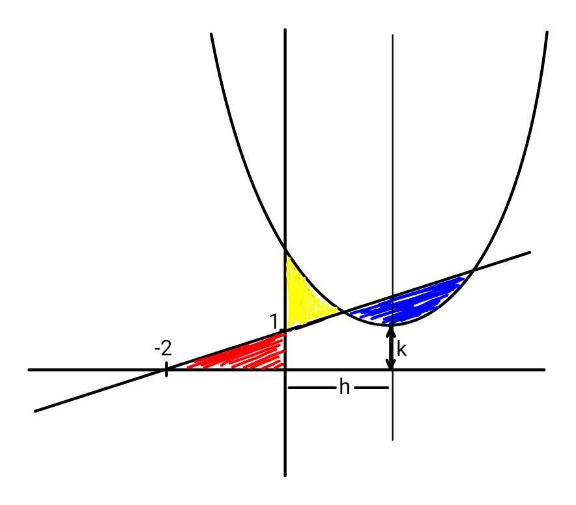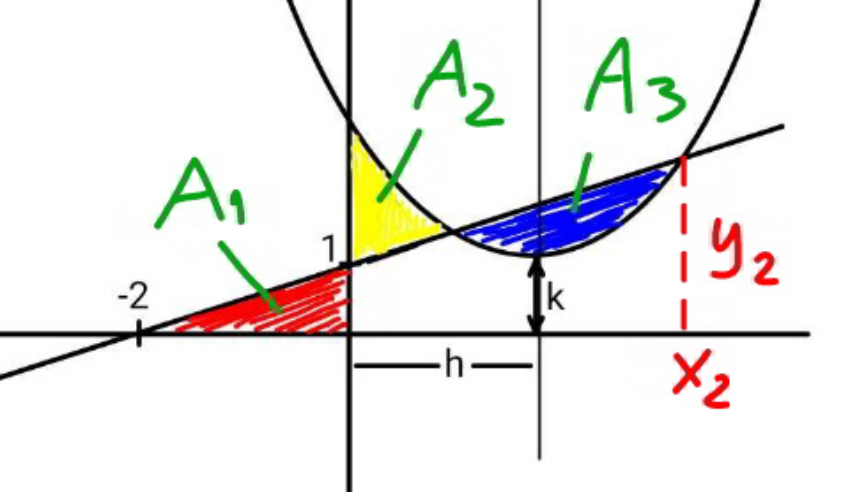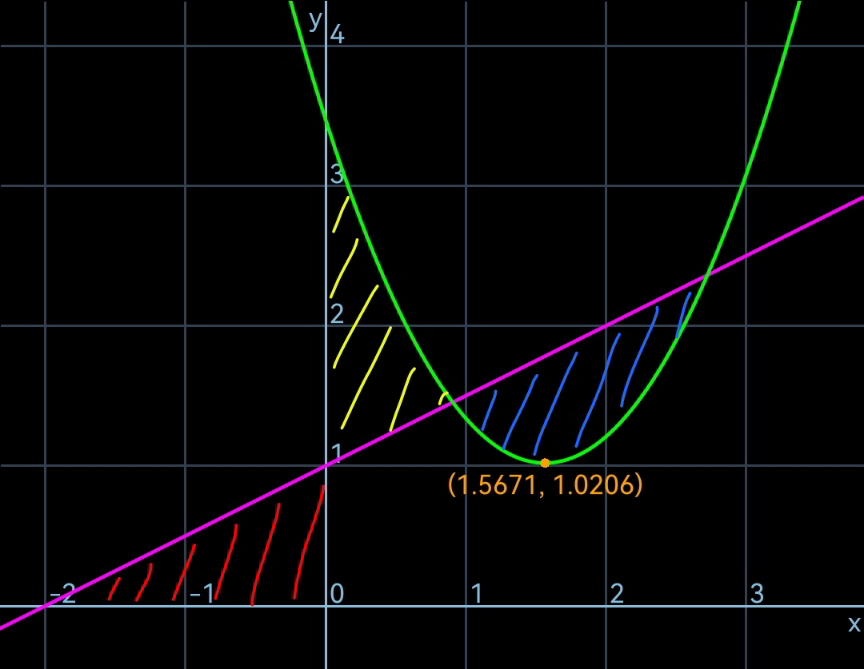
Question and Answers Forum
Question Number 184387 by ajfour last updated on 05/Jan/23

Commented by ajfour last updated on 05/Jan/23

Answered by mr W last updated on 06/Jan/23

Commented by mr W last updated on 06/Jan/23

Commented by mr W last updated on 07/Jan/23
![area of red triangle A_1 =((2×1)/2)=1 eqn. of line: y=(x/2)+1 eqn. of parabola: y=(x−h)^2 +k intersection of line and parabola: (x−h)^2 +k=(x/2)+1 (x−h)^2 −(((x−h))/2)+(k−1−(h/2))=0 ⇒x_2 −h=(1/4)+(1/4)(√(17+8h−16k)) ⇒y_2 =(9/8)+(h/2)+(1/8)(√(17+8h−16k)) area of blue region: A_3 =(1/6)[(1/4)−4(k−1−(h/2))]^(3/2) =A_1 =1 (1/6)[(1/4)−4(k−1−(h/2))]^(3/2) =1 17−16k+8h=4((36))^(1/3) ⇒k=(h/2)+((17)/(16))−(((36))^(1/3) /4) ⇒x_2 =h+(1/4)+((6)^(1/3) /2) ⇒y_2 =(h/2)+(9/8)+((6)^(1/3) /4) since A_2 =A_3 , area under the parabola is equal to area under the line from x=0 to x=x_2 . x_2 k+(h^3 /3)+(((x_2 −h)^3 )/3)=(((1+y_2 )x_2 )/2) (h+(1/4)+((6)^(1/3) /2))((h/2)+((17)/(16))−(((36))^(1/3) /4))+(h^3 /3)+((((1/4)+((6)^(1/3) /2))^3 )/3)=(((1+(h/2)+(9/8)+((6)^(1/3) /4))(h+(1/4)+((6)^(1/3) /2)))/2) ⇒h^3 +(3/4)(h+(1/4)+((6)^(1/3) /2))(h−((6)^(1/3) /2)−((36))^(1/3) )+((1/4)+((6)^(1/3) /2))^3 =0 since this is a cubic equation for h, exact solution is possible, but very complicated. we get approximately h≈1.5671, k≈1.0206](Q184406.png)
Commented by ajfour last updated on 06/Jan/23

Answered by ajfour last updated on 07/Jan/23
![If vertex of parabola is Origin. y=x^2 [eq. of parabola] y=(x/2)+(1+(h/2)−k) [eq. of line] say 1+(h/2)−k=m t^2 =(t/2)+m ∫_(−h) ^( t) (x^2 −(x/2)−m)dx=A (=0,1) ((t^3 /3)−(t^2 /4)+mt)+((h^3 /3)+(h^2 /4)+mh)=A ⇒ (t^3 /3)−(t^2 /4)+t^3 −(t^2 /2) +((h^3 /3)+(h^2 /4)+t^2 h−((th)/2))=A ⇒ (t+h){((t^2 −th+h^2 )/3)−(((t−h))/4) +t^2 −(t/2)}=A For A=0, t=t_2 as t+h≠0 ⇒ 4(t^2 −th+h^2 )+12t^2 +3h=6t+3t ⇒ 16t^2 −4th+4h^2 =9t−3h ⇒ 4((t^2 /h^2 )−(t/h)+1)=(3/h)(((3t)/h)−1) say (t/h)=s 4s^2 −(4+(9/h))s+(4+(3/h))=0 ⇒ s=(1/2)(1+(9/(4h)))±(√((1/4)(1+(9/(4h)))^2 −(1+(3/(4h))))) ⇒ 8hs=4h+9±(√((4h+9)^2 −16h(4h+3))) 8hs=4h+9±(√(81+24h−48h^2 )) ....](Q184465.png)
